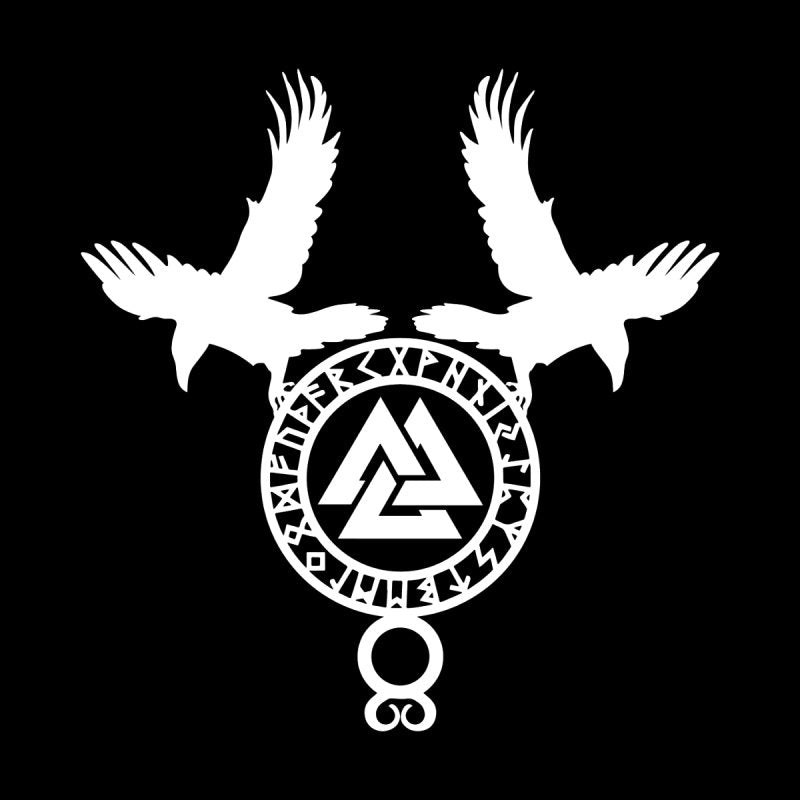One of the most common and enigmatic symbols commonly used by the Vikings is the Valknut. The Valknut is ever present in burials throughout the Viking world, yet no surviving literary source ever mentions it.
The Valknut symbol involves three interlocking triangles. It is known from the Viking world in two forms: The Borromean form, with three interlocking but separate triangles; and the unicursal form, drawn using a single line. It is generally though that these are variations of the same symbol as they appear in the same contexts.

Borromean Valknut and Unicursal Valknut
The Valknut is so secretive that even its true name is lost to history. Valknut is not the original name of the symbol, but a modern Norwegian name, created by the combination of the words for slain warrior, “valr”, and knot “knut”, to mean “knot of slain warriors”, for the Valknut appears to be associated with Odin and the valorous dead, chosen by His Valkyries to live in Valhalla.
Examples of the Valknut mainly survive on a number of Viking rune stones found in several burials sites. It appears on a pictorial memorial stone found on the Swedish island of Gotland and on grave goods included in the Oseberg ship burial in Norway, where it is inscribed on a bedpost, and appears on a tapestry, though the surviving image is extremely fragmentary.

Detail from Stora Hammars I stone in Gotland, Sweden
Similar symbols also appear on contemporary Anglo-Saxon funeral urns and on the grave goods of some Germanic people closely related to the Vikings, confirming the association between the Valknut and the death of a warrior.
The Valknut is not simply associated with death, but with a warrior’s death, as the symbol almost always appears alongside images of Odin or other symbols of the Allfather.
The chosen of Odin are warriors who died bravely in battle, taken by Odin’s servants, the Valkyrie, to live in Valhalla, Odin’s fabled hall in Asgard. In the Allfather’s hall, the valorous dead will feast and train until the day of the Ragnarök, when they will be called on to fight again, this time alongside the Gods in the final battle.

Valhalla
The Gotland memorial stone is the best example of an association between Odin and the Valknut. The stone shows the image of the Valknut above what seems to be a burial mound with a raven below. Standing nearby is a man with a spear, accompanied by another raven. The man with the spear is almost certainly Odin, carrying his enchanted spear Gungnir. The two ravens are his companion ravens Huginn and Muninn (thought and memory).
Behind the burial mound there is also shown a warrior hanging from a tree. This is another reference to Odin, as the Vikings often sacrificed their enemies to their God of war in this way. This was a reference to the story of Odin hanging himself from Yggdrasil, for nine days and nine nights, pierced by his own spear and sacrificing his own eye in order to gain the knowledge of the runes.

The four Stola Hamars Stones, in Gotland
It has also been suggested that the Valknut is Hrungnir’s Heart, a symbol that Snurri Sturluson mentioned in the Prose Edda. He describes the heart as made from stone and having three sharp corners. Nevertheless, most scholars have dismissed this interpretation in favor of an association with Odin.
Several theories have been suggested for the meaning of the Valknut. Some scholars have suggested that it was a symbol for reincarnation(!), others that it protected the dead soul against evil. The nine points of the triangle have been associated with the nine realms connected by Yggdrasil, and the three interconnected triangles have been said to reflect the connection between Midgard, Asgard and Hel. The symbol has also been associated with ecstatic Seidr magic, of which Odin was a master.
In Seidr magic, the Valknut was most likely a symbol possibly used to send valorous warriors that had not died in battle to Valhalla, with Odin selecting those who would serve him best in the final battle of Ragnarök. After all, the best warriors tend to be the ones standing at the end of the battle...
It is important to remember that the only reference of having to die in battle to gain entrance to Valhalla comes from the christian writer Snorri Sturluson, author of the Prose Edda and the Gylfaginning (the creation and destruction of the world of the Norse gods, and many other aspects of Norse mythology), back in the in the XIII century, a long time after the Viking age.

Snorri Sturluson
One of the reasons that the Valknut is so fascinating is that we don’t know exactly what it means, and we are forced to interpret it based on what we know of the Vikings. This means that for modern Vikings, the symbol can carry different, personal meanings, but its association with the Allfather remains undeniable.












